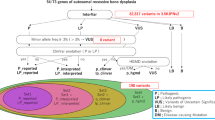Abstract
Pycnodysostosis is an autosomal recessive sclerosing skeletal dysplasia of unknown aetiology which is inherited with complete penetrance. The clinical features, fully delineated in 1962 by Maroteaux & Lamy1 and by Andrén et al.2, include osteosclerosis, acro-osteolysis of the distal phalanges, bone fragility, clavicular dysplasia, reduced stature and skull deformities with delayed suture closure. Although rare, pycnodysostosis has attained prominence because the French artist Henri de Toulouse-Lautrec was retrospectively diagnosed as having been affected with this disorder3,4. For rare autosomal recessive traits, homozygosity mapping provides a powerful approach to disease gene mapping5,6. We have now used this approach to map the locus for pycnodysostosis. Following a genome-wide search in a large Arab family with 16 affected relatives7, we established linkage to a narrow region on chromosome 1q21, with a maximal lod score of 11.72. A single marker, D1S498, was homozygous-by-descent in all affecteds and defined the gene locus to a region of 4 cM. Two candidate genes in the region — the interleukin-6 receptor gene (IL6R) and the myeloid cell leukaemia-1 gene (MCL1) — are involved in the differentiation of monocyte/macrophages into osteoclasts, the most likely site of the primary defect in pycnodysostosis8.
This is a preview of subscription content, access via your institution
Access options
Subscribe to this journal
Receive 12 print issues and online access
$209.00 per year
only $17.42 per issue
Buy this article
- Purchase on Springer Link
- Instant access to full article PDF
Prices may be subject to local taxes which are calculated during checkout
Similar content being viewed by others

References
Maroteaux, P. & Lamy, M. La pycnodysostose. Presse Med. 70, 999–1002 (1962).
Andren, L., Dymling, J.F., Hogeman, K.E. & Wendeberg, B. Osteopetrosis acro-osteolytica: A syndrome of osteopetrosis, acro-osteolysis and open sutures of the skull. Acta Chir. Scand. 124, 496–507 (1962).
Maroteaux, P. & Lamy, M. The malady of Toulouse-Lautrec. J. Am. med. Assoc. 191, 715–717 (1965).
Maroteaux, P. La maladie de Toulouse-Lautrec. Presse Med. 23, 1635–1640 (1993).
Lander, E.S. & Botstein, D. Homozygosity mapping: A way to map human recessive traits with the DMA of inbred children. Science 236, 1567–1570 (1987).
Kruglyak, L., Daly, M.J. & Lander, E.S. Rapid multipoint linkage analysis of recessive traits in nuclear families, including homozygosity mapping. Am. J. Hum. Genet. 56, 519–527 (1995).
Edelson, J.G., Obad, S., Geiger, R., On, A. & Artul, H.J. Pycnodysostosis: orthopedic aspects with a description of 14 new cases. Clin. Orthop. 280, 263–276 (1992).
Greenspan, A. Sclerosisng bone dysplasias- a target-site approach. Skeletal Radiol. 20, 561–583 (1991).
Gyapay, G. et al. The 1993–94 Genethon human genetic linkage map. Nature Genet. 7, 246–330 (1994).
Hoggard, N. et al. Mapping regions of allelic imbalance on chromosome 1 in human breast cancer. Cytogenet.Cell Genet. 67, 168 (1994).
Kluck, P.M.C. et al. The human interleukin-6 receptor alpha chain gene is localized on chromosome 1 band q21. Hum. Genet. 90, 542–544 (1993).
Craig, R.W. et al. Human and mouse chromosomal mapping of the myeloid cell leukemia-1 gene: MCL1 maps to human chromosome 1q21, a region that is frequently altered in preneoplastic and neoplastic disease. Genomics 23, 457–463 (1994).
Kishimoto, T., Akira, S. & Taga, T. IL-6 receptor and mechanism of signal transduction. Int. J. Immunopharmac. 14, 431–438 (1992).
Tamura, T. et al. Soluble interteukin-6 receptor triggers osteoclast formation by interleukin 6. Proc. Natn. Acad. Sci. U.S.A. 90, 11924–11928 (1993).
Hoyland, J.A., Freemont, A.J. & Sharpe, P.T., IL-6 receptor, and IL-6 nuclear factor gene expression in Paget's disease. J. Bone miner. Res. 9, 75–80 (1994).
Kopf, M. et al. Impaired immune and acute-phase responses in interleukin-6-deficient mice. Nature 368, 339–342 (1994).
Balena, R. et al. Interleukin-6 deficient mice are protected from bone loss by estrogen depletion. EMBO J. 13, 1189–1196 (1994).
Kozopas, K.M., Yang, T., Buchan, H.L., Zhou, P. & Craig, R.W. MCL1, a gene expressed in programmed myeloid cell differentiation, has sequence similarity to BCL2. Proc. Natl. Acad. Sci. U.S.A. 90, 3516–3520 (1993).
Vaux, D.L., Cory, S. & Adams, J.M. Bcl-2 gene promotes hemopoietic cell survival and cooperates with c-myc to immortalize Pre-B cells. Nature 335, 440–442 (1988).
McKusick, V.A. Abraham Lincoln and Marfan syndrome. Nature 352, 280 (1991).
Herrmann, J., France, T.D., Sprager, J.W., Opitz, J.M. & Wiffler, C., Stickler syndrome (hereditary arthroophthalmopathy). Birth Defects Orig. Art.Ser. XI, 76–103 (1975).
Macalpine, I., Hunter, R. & Rimington, C. Porphyria in the royal houses of Stuart, Hanover, and Prussia: A follow-up study of George III's illness. Brit. Med.J. 1, 7–18 (1968).
Wolf, P.L. If clinical chemistry had exited then…. Clin. Chem. 40, 328–335 (1994).
McKusick, V.A. The royal hemophilia. Sci. Am. 213, 88–95 (1965).
Loftus, L.S. & Arnold, W.N. Vincent van Gogh's illness: Acute intermittent porphyria? Brit. med. J. 303, 1589–1591 (1991).
O'Shea, J.G., Chopin's illness actually cystic fibrosis? Med. J. Aust. 147, 586–589 (1987).
Frey, J. Toulouse-Lautrec: A life. (Viking Press, New York, 1994).
Anderson, M.A. & Gusella, J.F. Use of cyclosporin A in establishing Epstein-Barr virus-transformed human lymphoblastoid cell lines. In Vitro 20, 856–858 (1984).
Verma, R.S. & Babu, A. Human chromsomes: principles and techniques. 2nd edn, 134–136 (McGraw-Hill, Inc., New York, 1995).
Lathrop, G.M., Lalouel, J.M., Julier, C. & Ott, J. Multilocus linkage analysis in humans: Detection of linkage and estimation of recombination. Am. J. hum. Genet. 37, 482–498 (1985).
Author information
Authors and Affiliations
Rights and permissions
About this article
Cite this article
Gelb, B., Edelson, J. & Desnick, R. Linkage of pycnodysostosis to chromosome 1q21 by homozygosity mapping. Nat Genet 10, 235–237 (1995). https://doi.org/10.1038/ng0695-235
Received:
Accepted:
Issue Date:
DOI: https://doi.org/10.1038/ng0695-235
This article is cited by
-
La piconodisostosi: un modello naturale per la terapia dell’osteoporosi
L'Endocrinologo (2024)
-
Multiple Fractures and Impaired Bone Fracture Healing in a Patient with Pycnodysostosis and Hypophosphatasia
Calcified Tissue International (2019)
-
From disease to treatment: from rare skeletal disorders to treatments for osteoporosis
Endocrine (2016)
-
A Mutation in CTSK Gene in an Autosomal Recessive Pycnodysostosis Family of Chinese Origin
Calcified Tissue International (2015)
-
Cathepsin K analysis in a pycnodysostosis cohort: demographic, genotypic and phenotypic features
Orphanet Journal of Rare Diseases (2014)


